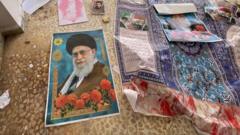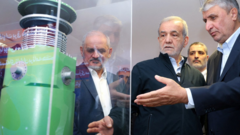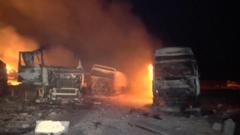#### The departure of Iranian military from their once-dominant positions in Syria marks a significant turning point in the country's ongoing conflict and shifts the balance of power in the region.
### Iran’s Military Collapse in Syria: The Last Retreat of an Expanding Empire

### Iran’s Military Collapse in Syria: The Last Retreat of an Expanding Empire
#### A dramatic shift unfolds as Iranian forces abandon their strategic bases in Syria, revealing the consequences of internal rifts and external pressures.
The narrative of Iranian military dominance in Syria has unraveled rapidly, with once-thriving bases now lying in disarray. Crates of rotting food, discarded uniforms, and remnants of weapons illuminate an exodus that has left a haunting representation of panic and desperation. With the withdrawal of Iranian forces, homes and positions that symbolized over a decade of influence are now overtaken by remnants of other factions, underpinning the profound volatility of the region.
For over ten years, Iran stood as Syrian President Bashar al-Assad's principal ally, embedding its military presence through the deployment of advisers, foreign militias, and infrastructural investments, all in an effort to fortify a "security belt" against perceived threats, primarily Israel. However, the strategic location near Khan Shaykhun, which once served as a critical node in Iran's operations, has witnessed an abrupt transformation.
This former Iranian base, shrouded in secrecy and heavily fortified with hidden routes and bunkers, now tells a story of a fractured alliance. As fresh evidence emerges—a receipt for supplies and personal documents with sensitive information left behind—the chaotic departure becomes clear. Forces fled with scant preparation, some scrambling to evacuate to Lebanon or Iraqi territories under Russian guidance, indicative of a disorganized retreat provoked by a sudden escalation in hostilities.
The deterioration of Iranian influence stems not just from external military pressure but also from a significant rift between Assad's regime and Tehran. Observations from local fighters reveal deepening distrust; Iranian forces accused Assad of betraying their alliance and potentially collaborating with their adversaries. The psychological impact reverberated, suggesting a crippling blow delivered not only from outside actors but from internal fractures.
Amidst this chaos, local Syrians express a complex array of sentiments toward their newfound liberators. While former Iranian loyalists felt oppressive oversight, the sudden vacuum left by the Iranians has been met with mixed reactions. The recent local authorities, now asserting control over these areas, have vocalized a clear stance against Iran’s participation in Syria’s future, although tentative connections have not been entirely cast aside.
In the wake of Iran's military retreat, the new dynamics pose critical questions about the future of influence and power in the region. While Tehran's response has ranged from militant rhetoric promoting resistance to a more measured acknowledgment of the Syrian people's sovereignty, the Syrian populace remains wary of Iranian resurgence in any form. The remnants of the Iranian military presence symbolize a period of occupation that many are eager to leave behind, yet the permanence of these shifts will depend on the actions of both local authorities and regional players moving forward.
As the dust settles on this chapter of conflict, the echoes of Iran's extensive military campaigns within Syria reflect a landscape of destruction—both in their operational strategies and in their standing with the local populace. Once-forged partnerships are now severely rattled, leaving the future of Iranian influence uncertain in the face of emerging Syrian governance.
For over ten years, Iran stood as Syrian President Bashar al-Assad's principal ally, embedding its military presence through the deployment of advisers, foreign militias, and infrastructural investments, all in an effort to fortify a "security belt" against perceived threats, primarily Israel. However, the strategic location near Khan Shaykhun, which once served as a critical node in Iran's operations, has witnessed an abrupt transformation.
This former Iranian base, shrouded in secrecy and heavily fortified with hidden routes and bunkers, now tells a story of a fractured alliance. As fresh evidence emerges—a receipt for supplies and personal documents with sensitive information left behind—the chaotic departure becomes clear. Forces fled with scant preparation, some scrambling to evacuate to Lebanon or Iraqi territories under Russian guidance, indicative of a disorganized retreat provoked by a sudden escalation in hostilities.
The deterioration of Iranian influence stems not just from external military pressure but also from a significant rift between Assad's regime and Tehran. Observations from local fighters reveal deepening distrust; Iranian forces accused Assad of betraying their alliance and potentially collaborating with their adversaries. The psychological impact reverberated, suggesting a crippling blow delivered not only from outside actors but from internal fractures.
Amidst this chaos, local Syrians express a complex array of sentiments toward their newfound liberators. While former Iranian loyalists felt oppressive oversight, the sudden vacuum left by the Iranians has been met with mixed reactions. The recent local authorities, now asserting control over these areas, have vocalized a clear stance against Iran’s participation in Syria’s future, although tentative connections have not been entirely cast aside.
In the wake of Iran's military retreat, the new dynamics pose critical questions about the future of influence and power in the region. While Tehran's response has ranged from militant rhetoric promoting resistance to a more measured acknowledgment of the Syrian people's sovereignty, the Syrian populace remains wary of Iranian resurgence in any form. The remnants of the Iranian military presence symbolize a period of occupation that many are eager to leave behind, yet the permanence of these shifts will depend on the actions of both local authorities and regional players moving forward.
As the dust settles on this chapter of conflict, the echoes of Iran's extensive military campaigns within Syria reflect a landscape of destruction—both in their operational strategies and in their standing with the local populace. Once-forged partnerships are now severely rattled, leaving the future of Iranian influence uncertain in the face of emerging Syrian governance.




















